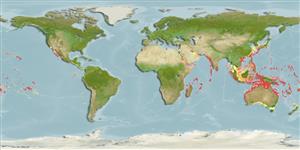Common names from other countries
Classification / Names / Names
ماع يماسا | فدارتم | Catalog of Fishes (gen., sp.) | ITIS | CoL | WoRMS
Environment: milieu / climate zone / depth range / distribution range
يسانش موب
; قمع تارييغت 11 - 62 m (Ref. 3099). Tropical
Indo-Pacific.
Length at first maturity / Size / Weight / نس
Maturity: Lm ? range ? - ? cm Max length : 9 cm TL (female)
Minimum depth from Ref. 80410. Intertidal to subtidal (Ref. 106854). Inhabits sandy bays (Ref. 3533); shallow waters in sand flats, seagrass beds with coral rubble substrate (Ref. 80538) and also in reef flats or tidal flats under rock or boulders or inside rock crevices (Ref. 87055). Stomatopods are predators that require living prey (Ref. 833).
Life cycle and mating behavior
غولب | لثم دیلوت | یزیر مخت | اه مخت | Fecundity | )ورال ( دازوت
Some members of the order Stomatopoda pair for life and some come together only to mate. Males produce sperm ducts rather than spermatophores; females can brood a maximum of 50,000 eggs. Life cycle: Eggs hatch to a planktonic zoea which lasts for 3 months.
یلصا ذخآم
عجارم | هدننك گنهامه | ناراكمه
Ahyong, S.T. 2001. (Ref. 3099)
NCUI زمرق تسرهف رد تيعضو (Ref. 130435)
ستياس رظن زا تيعضو (Ref. 108899)
Not Evaluated
Not Evaluated
اه ناسنا یارب رطخ
Harmless
یناسنا هدافتسا
| FishSource |
اهرازبا
رتشيب تاعالطا
Age/Sizeدشرنزو - لوطلوط - لوطيسانش تخير)ورال ( دازوتيناوارف
يتنرتنيا عبانم
Estimates based on models
Preferred temperature
(Ref.
115969): 24.3 - 29, mean 27.8 (based on 912 cells).
